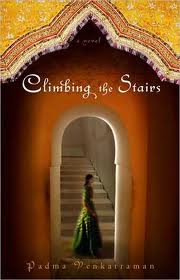Climbing the Stairs by Padma Venkatraman
Reviewed by Jennifer

Ratings Explanation
Language: “Son of a prostitute” used as a curse. Vidya’s father is referred to as an “idiot” once he is injured. The story takes place during WWII and the Japanese are referred to as “Japs.” India and her resources “raped” by British. “Slut” used in reference to Vidya.
Violence: British policemen attack Indian protesters. A woman is hit repeatedly with a stick and her sari is torn off, exposing her breasts. Vidya’s father picks up the injured woman to protect her and he is then beaten. His injuries result in severe brain damage. Vidya’s teacher canes her hand for lying.
Sexual Content: Women are banished to an outhouse during their period. The extended family lives together with the women sleeping on the bottom floor and the men sleeping upstairs. The married couples take turns spending nights in the “couples room.” A “sweaty night meeting” referred to in the couples room. When Vidya’s cousin gets married, “consumating the marriage” is mentioned.
Adult Themes: The caste system in WWII India. Servants of lower castes are not allowed in the kitchen or dining room or to drink from the same cups as their social superiors. British Imperialism. The British generally treat the Indians poorly, call them derogatory names. Gender issues. Arranged marriages. Women serve men.
Synopsis
At a time when the world is at war, 15-year-old Vidya lives a happy life with her family. She loves school and wants very much to attend college, but that is almost unheard of in 1941 India, where girls are expected to marry and have children, not get an education. Her father, however, promises that Vidya will get her wish.
When Vidya and her father are caught in an Indian protest against the British occupation, he is beaten by British police while trying to help an injured woman. His injuries are so severe that he can no longer provide for his family and they are forced to move in with Vidya’s grandfather and their extended family. In this traditional household, Vidya is terrified that she will be married off and never realize her dream of getting an education, but when she meets a young man living in the same house, her feelings about marriage begin to change.
This book takes an interesting look at WWII British-occupied India. My knowledge of India is lacking and I enjoyed learning a little more about their culture and the non-violent resistance movement aimed at gaining their independence from England.
I am always drawn to books with strong female characters and I admired Vidya’s persistence and determination. This is a good book to spark a discussion on women’s rights and roles in society and history.
©2009 The Literate Mother









